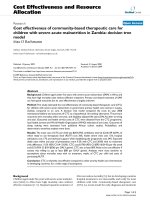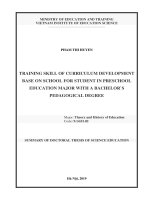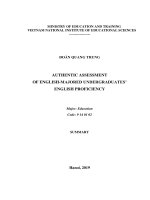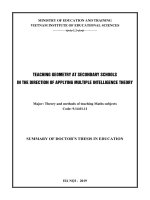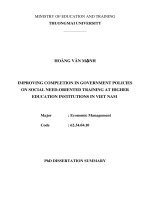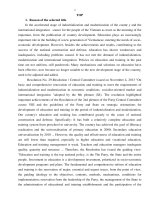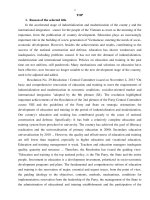Dissertation summary for doctoral philosophy program in education: Methods to develop communication skills for children with autism 3 4 years old
Bạn đang xem bản rút gọn của tài liệu. Xem và tải ngay bản đầy đủ của tài liệu tại đây (380.38 KB, 14 trang )
MINISTRY OF EDUCATION AND TRAINING
THE VIETNAM INSTITUTE OF EDUCATIONAL SCIENCES
NguyEn ThI Thanh
METHODS TO DEVELOP COMMUNICATION SKILLS FOR
CHILDREN WITH AUTISM 3-4 YEARS OLD
Major: Education
Code: 62.14.01.02
dissertation SUMMARY FOR
doctoral philosophy PROGRAM in education
Hanoi – 2014
THIS WORK WAS FINISHED AT THE VIETNAM INSTITUTE OF
EDUCATIONAL SCIENCES
MINISTRY OF EDUCATION AND TRAINING
Supervisors: 1. A/Prof. Nguyen Van Le, PhD
2. A/Prof. Le Van Tac, PhD
Defender 1:
PGS.TS. Đang Thanh Hung,
Workplace: Ha noi National University of education No 2
Defender 2:
PGS.TS. Vu Trong Ry
Workplace: The Viet Nam institute of education sciences
Defender 3:
PGS.TS. Tran Thi Tuyet Oanh,
Workplace: Ha noi National University of education
The dissertation will be defensed at the Defense Committee held at The
Vietnam Institute of Educational Sciences.
At … … date……………………………………………………
The dissertation can be found at:
- The Vietnam National Library
- Library of The Vietnam Institute of Educational Sciences
PUBLICATIONS RELATED TO THE DISSERTATION
1. Nguyen Thi Thanh (2008). Measures to deal with atypical behaviors for children
with autism. Magazine of Educational Sciences. Vol. 31, p.13-16.
2. Nguyen Thi Thanh (2013). Communication characteristics of children with
autism. Magazine of Educational Equipments. Vol. 89. p.42-46
3.Nguyen Thi Thanh (2013). Assessment for children with autism. Magazine
of Educational Equipments. Vol.90, p.10-14
4. Nguyen Thi Thanh (3/2013). Measures to develop communication skills for
children with autism. Magazine of Educational Sciences. Vol.90, p.53-56
5. Nguyen Thi Thanh (11/2013). The role of social worker for children. The
proceeding at the Conference at National College of Education.
6. Nguyen Thi Thanh (12/2013). Measures to enhance the quality of
practicum for the dual program of Early Childhood Education and Special
Education. The proceeding at the Conference at the National College of
Education.
1 2
INTRODUCTION
1. The research rationale
Children with autism (CwA) refers to individuals who suffer from series
of neurological impairments and these deficits create difficulties in
communication, social and behaviors and also create barriers to integrate in
the society for children. From this point, it is realized that the impact of these
deficits is significant. CwA is varied from mild to profound and the
characteristics are also varied. However, it is a unique that all CwA express
the same difficulty in communication and social interaction.
In daily life activities including schooling activity, CwA experience the
most difficulty in communication, they do not know to verbally communicate
with teachers, classmates and people around them. Children live and act in
their own world, isolated and difficult to acquire content communication from
communication partners and educational program… Furthermore, recent
researching on education for children with CwA is a new discipline in
Vietnam; therefore, preschool teachers have limitted in theoretical knowledge
and practical experience as well as the lack of materials guiding about
communication for CwA so they have obscurity when communicate with
children. In fact, preschool teachers have communicated and instructed for
CwA by their own natural feeling and experience and this have direct
influence on the quality of education for children. Therefore, the inquiry
“Methods to develop communication skills (CS) for CwA 3-4 years old” was
chosen to implement with the hope to partly contribute to improve the quality
of education and care for CwA and to develop the educational sciences in
Vietnam particularly.
2. Research objective
Based on theoretical and practical foundation about communication skills of
CwA, the dissertation proposes and experiments methods to improve the
communication skills for CwA.
3. Research subject and object
3.1. Research subject: The educational process to develop communication
skills for CwA 3-4 years old.
3.2. Research object: Methods to develop communication skills for CwA 3-4
years old.
4. Research hypothese
CwA have limited in communication skills.If methods to develop
communication skills are created synchronously from family to school and
society, linked between intervention and education, provided various
opportunities for children to integrate community, express and experience and
practice communication skills in order to improve the care and education
efficiency for CwA in general and develop communication skills for CwA
particularly.
5. Research task
5.1. Theoritical research about communication skills of CwA.
5.2. Fact investigation of communication skills in CwA 3-4 years old;
5.3. Propose of methods to develop communication skills for CwA 3-4 years
old and educational experiment in order to validate the feasibility and
efficiency of proposed methods.
6. Research scope
Research and propose methods to develop communication skills for
CwA 3-4 years old who are in inclusive classes at kindergarten schools,
exclude children with Asperger Syndrome, delay disorders, pervasive
developmental disorders, Rett Syndrome. The research project was
implemented in Hanoi.
7. Research methodology
7.1. Theoretical research methods: Use methods to analyze, summary,
category and systemize theories.
7.2 Data collection and experiment methods: Use observation, questionnaire,
3 4
educational products, educational experiment and case study.
7.3. Analyzing methods: Software SPSS 16.0 is used to analyze data in order to
measure the qualitative and quantitative results from the research.
8. Research significance
8.1. Theoritical contribution
- To clarify the definition and characteristics of the process of developing
communication skills of CwA, methods to develop communication skills for
CwA in order to enrich the theoretical foundation about education for CwA.
- To determine the teacher’s impact of the environment of inclusive education
on development of communication skills, to review literature on inclusive
education (IE) for CwA.
- To compose methods developing communcation skills for CwA in the
inclusive class in preschools and this is a foundation for developing guiding
manual for parents and teachers.
8.2. Clinical contribution
The dissertation evaluated the status of communication skills of CwA
and methods used to develop communication skills for CwA in inclusive
classes in preschools currently. Methods for developing communication skills
for CwA 3-4 years old that were proposed and proven through educational
experiment are valuable in education for CwA and are reference materials for
management, research, pre-service and in-service training preschool teachers
and information for parents in inclusive education preschool-age CwA.
9. Dissertation structure
Dissertation includes introduction, conclusion, references, appendices and 3 chapters:
Chapter 1: Theoretical and situational foundation of developing
communication skills for CwA 3-4 years old
Chapter 2: Propose methods to develop communication skills for CwA 3-4 years old
Chapter 3: Experiment proposed methods developing communication skills for CwA
3-4 years old.
CHAPTER 1
THEORETICAL FOUNDATION ABOUT METHODS DEVELOPING
COMMUNICATION SKILLS FOR CHILDREN WITH AUTISM
1.1. Literature review
Research on CwA, characteristics on CwA and developing
communication skills for CwA had been done by many researchers in and
outside Vietnam. The authors had focused on directions as follows:
Firstly, research to clarify identifying period of CwA. This direction
was carried out in the research of Leo Kanner and Han Asperger.
Secondly, research on characteristics of CwA had been done by many
well-known research who spent many years on different research, for
example, Eric Schopler, Lorna Wing, Bryna Seigel, Rechard G.J… These
researchers had helped the community to more understand of characteristics as
well as to give answers for myths about this syndrome.
Thirdly, research on diagnostic and assessment tools for CwA had done
by Baron- Cohen, Allen and Gilber, American Psychiatic Association
Diagnostic and assessment tools for CwA such as: MCHAT, CARS, DSM-IV.
Fourthly, research on characteristics of communication of CwA had done
by Ivar Lovaas; Quách Thúy Minh, Nguyễn Văn Thành, Nguyễn Tinh Vân.
Fifthly, research on methods supporting CwA in inclusive preschools
had done by Cole.E.B., Ling D, Nguyễn Thị Diệu Anh, Nguyễn Tinh Vân.
This dissertation followed the approach of integration between the second and
the fifth directions in order to research on methods to develop communication
skills for CwA in inclusive classes in preschools.
Currently, there is no research result published in Vietnam
comprehensively focusing on developing communication skills for CwA in
inclusive classes in preschool. The investigation and introducing research
results from researchers outside Vietnam has also limited.
1.2. Basic definitions
5 6
1.2.1. Skill: Skill is a complex issue and its definition is varied. In this inquiry, we
define skill is human ability that is done maturely based on experience through
the process of practice in order to obtain targeted results.
1.2.2. Communication skill
1.2.2.1. Communication: In this dissertation, we choose the definition
“Communication is expressing, exchange information through understanding
and expressing language in speech, facial expression, gestures. Through
communication, personality is established and developed”.
1.2.2.2. Communication skill
We use the definition communication skill is an ability to use
appropriately both language and non-verbal language, to know how to
organize, to adapt communication process in order to target communication
goals. For CwA, we focus on developing skills such as attention, immitation,
take turn, understanding and using language in order to build up foundation
for enhance communication skills for CwA.
1.2.3. Methods to develop communication skill
Methods to develop communication skills for CwA is ways to
implement educational impact to support CwA having skills used in
communication process such as attention, immitation, receptive and
expressive language in order to express for others to understand
communication content.
1.2.4. Inclusive education: Inclusive education is educational approach in
which CwA learn with normal children in mainstream schools.
1.3. Basic issue about children with autism
1.3.1. Children with autism
CwA are children who show the lack of emotional interact with
others; repeat ritual habits; delay in spoken language or spoken language is
atypical; have typically stereo behaviors; limit in abstract thinking.
1.3.2. Causes of autism
Since 1943, science has not determined exactly about the causes of
autism. An overview of causes of autism showed that there are many causes.
There is a cause related to environment factors, for example, watching
television too much, hinder children in communication and integration with
others surrounding. This is a clue for this dissertation to develop methods to
deal with difficulties of CwA.
1.3.3. Tools for diagnosis and assessment children with autism
We used DSM-IV and CARS in order to determine autism, autism degree and
checklists of development skills in Book number 8 in the Small Step Program
in order to assess developmental domains as foundation for this research.
1.3.4. Characteristics Communication of children with autism
- characteristics
* Limitation in relation: Children show the significant limitation in interaction
between people, almost CwA express the isolation, self-playing preference,
avoid communicating with friends. This limitation on social relation is the
most popular in CwA. This limitation directly impacts on cognition
development and social relation skills particularly of CwA.
* Limitation in comprehensive understanding speech: In daily regular
communication, CwA do not pay attention on speech of communication
partners. Those do not response when being called their names, do not pay
attention to others surroundings, do not follow instruction given by others
while they have listening skills as normal children.
* Limitation in expressive speech: The impairment in expression, use speech
in communication in CwA is popular and varied in different modes. Almost
milestones of spoken language development in CwA is slower than the typical
development children.
CwA have typical characteristics in communication, attention,
intelligence, language, behaviors, sensory, social interaction, etc., Based on
these characteristics, we propose methods to minimize deficits for CwA.
7 8
1.4. Developing communication skills for children with autism
1.4.1. The role of developing communication skills for children with autism
Through communication, teacher can identify psychological
characteristics, the need, expectation as well as the limitation the children and
their families may have. From those, teachers can discuss with and collaborate to
family, children, other teachers in order to build up the content, educational
methods and suitable and effective intervention for children.
1.4.2. Objectives of developing communication skills for children with autism
The objectives of developing communication skills for CwA is
support children used communication skills such as: attention, immitation,
take turn, listening and performing verbal instruction, use
guesture/speech/action to communicate with other people surrounding. Those
build up foundation for establishment and development personality, social
skills and social integration.
1.4.3. The content of developing communication skills for children with autism
The content of developing communication skills for CwA are
developing basic skills such as: Attention skills, immitation and take turn
skills, understanding and using language.
1.4.4. Development ways for children with autism
In order to develop communication skills for CwA, it needs some
basic ways, such as: Integration between organizing early intervention
activities with inclusive education; Opportunity for CwA joining in
community activities such as shopping, visiting parks, supermarket, sight
seeing; Organizing activities at home in oder to develop communication
relation between family members such as grandparents, parents, siblings,
relatives,… and children with home objects; Organizing social activities that
collaborated with different stakeholders to focus on developing
communication skills for CwA.
1.4.5. Influent factors on communication skills for children with autism
Children ability; Teacher competency; Home environment; Friendship;
Classroom environment; Social environment.
Summary chapter 1
1. CwA are children who have poor communication and interaction, delayed
in spoken language and sterotyped behaviors. The most difficulty for CwA in
daily life is communication.
2. The goals of developing communication skills of CwA depend on factors
such as attention, autism degree, related syndromes with autism, particularly
the factor of early intervention cooperating with intervention activities
implementing in the environment of inclusive education.
3. Organizing activities to develop communication skills for CwA need to
intensively research to match with reality and typical characteristics of CwA.
4. In order to develop communication skills for CwA in inclusive classes in
preschool, it needs to investigate for proposing concrete methods for teachers to
apply easily in their work to develop communication skills for CwA.
CHAPTER 2: PRACTICAL FOUNDATION AND METHODS DEVELOPING
COMMUNICATION SKILLS FOR CHILDREN WITH AUTISM
2.1. Practical foundation of methods developing communication skills for CwA
2.1.1. Development of inclusive education for CwA in Vietnam
Currently in Vietnam, CwA have opportunity to access inclusive
education at preschool. Leading by Ministry of Education and Training,
management system of education for children with disabilities has built up
nationwide and acted effectively (including Steering Committee of Education
for children with disability from national to local levels). Care and education
for CwA at preschools have greatly improved. In order to support CwA
develop well in all aspects and develop communication skills, it needs to
investigate to sort out methods that suitable with children and the environment
9 10
of inclusive education.
2.1.2. Brief introduction about development communication skill in Vietnamese
current preschool curriculum
Preschool curriculum enacted in 2009 is compiled towards national
framework and integration. The program content is structured in 05 areas: Physical,
Cognition, Language, Social-Emotional, and Aesthetic Development and those are
integrated by themes and it enables CwA to increase vocabulary and opportunities
to develop communication skills. The content of developing communication skills
for CwA is integrated in different activities.
2.1.3. Investigation of education of communication skills for CwA 3-4 years old
2.1.3.1. Introduction of investigation
* Objective: Evaluate the teachers’ awareness of the importance of development
communication skills for CwA; teachers used methods to organize activities for
development communication skills for CwA; the current communication skills that
CwA have. Those investigation results are foundation to propose methods for
development communication skills for CwA.
* Content: In order to gain above research objective, we clarify the content for
investigation as follows:
- Teachers’ awareness of development communication skills for CwA
- Methods that teachers have currently used for development communication
skills for CwA
- Advantages and disadvantages teachers experience while organizing
activities to develop communication skills for CwA.
- Level of communication skills development of CwA 3-4 years old in
inclusive preschool in terms of attention, immitation, take turn,
comprehensive listenning and language use.
* Investigation sample and location
- Investigate teachers through questionnaire, observation and interview: 60
teachers who work in inclusive classes having CwA in districts such as Cau
Giay, Dong Da, Ba Dinh in Hanoi; teachers almost are qualified as preschool
teacher with 58,4% graduated college, 31,6% graduated university, 10%
graduated vocational schools, no one has master degree.
- Investigate CwA by observation and playing games: 30 CwA 3-4 years old in Cau
Giay, Dong Da, Ba Dinh districts in Hanoi. We also used CARS for diagnostis with
23,4% CwA at mild degree, 60% CwA with severe degree and 16,6% CwA with
profound degree who are all learning in inclusive preschool classes.
- Investigation location: in Cau Giay, Dong Da, Ba Dinh districts in Hanoi.
* Investigation methods and tools
Methods
- Questionnaire: Questionnaire for teachers working with CwA in inclusive
preschool classes includes questions about their knowledge about
communication skills development for CwA.
- Observation: Observe 20 activities (learning sessions, playing, lunch time,
napping time, greeting and going home activities) in preschools in normal
condition with prior informing. Then we analyze statistics to generate results
(Appendix 6).
- Product evidence: evaluate 15 programs designed by teachers about
educational activities in oder to investigate educational objectives whether or
not are adapted for CwA? The ways teachers implement are suitable with
CwA ability and do they work effectively for CwA?. We mark those
program/Plan in 10 criteria equivalence to 10 points.
- Deep interview: Interview 15 parents having CwA in order to validate
information collecting for data investigation (Appendix 7).
Tools
- Questionnaire: For teachers working in inclusive preschool classes having
CwA, it includes questions about development CS for CwA. We deliver
questionnaire for teachers for their filling information in then we collect fulfill
paper, all questionnaire is anonymous (Appendix 5).
11 12
- Skill assessment checklist: in order to assess CS of CwA 3-4 years old in
inclusive preschool classes in 5 criteria (Appendix 2).
2.1.3.2. Result of teachers awareness of the importance of development CS for CwA
96,6% teachers agreed that development CS is very essential, 3,4%
agreed that it is not essential because of the reason that CwA in their classes
are profound and have no language yet. The most importance for teachers at
high priority is how teacher CwA to speak.
2.1.3.3. Result of methods teachers used to develop CS for CwA in inclusive preschool classes
Methods teachers used daily to develop CS for CwA as follows:
Level
Name method
fry sometime never
- Understand CwA by searching information
about the child, assessment communication
ability of each child
0% 25% 75%
- Develop Plan to develop CS for CwA
0% 20% 80%
- Organizing for CwA playing in corners
0% 23% 67%
- Encouragement CwA use spoken language
0% 15% 85%
- Create problem situation in the daily to
stimulate CwA communicate
0% 26,6% 74,4%
- Establish close relationship between
teachers, other children with CwA
0% 10% 90%
- Establish friend circle to encourage CwA
communicate
0% 21,6% 79,4%
- Assign tasks for CwA in daily activities
0% 23,3% 76,7%
- Create opportunity for CwA to expose, inteact
with community to help CwA have more
confident for communication
0% 31,7% 68,3%
- Practice communication for CwA by pictures
0% 18,3% 81,7%
- Practice eye contact while communicating
with teachers and friends
0% 11,6% 88,4%
- Give daily homework for parents
0% 20% 80%
- Collaborate with parents to develop CS for
CwA in daily activities
0% 45% 55%
In short, methods teachers used in daily activities we realize. Basically,
teachers have awareness of the importance of development CS for CwA 3-4
years old. Meanwhile, teachers try to select and apply some methods to
develop CS for CwA. However during process of applying, these methods are
not flexible and do not understand those methods role for CwA, lack of
collaboration. When using, it is isolated, lack of systematical flow. Therefore,
communication ability of CwA is lack of practice opportunity, CwA is not
active in all daily activities. In order to develop CS for CwA, it is essential for
teachers to use synthetically methods and ways to develop, enhance
vocabulary, communicate with teachers and friends, then enables to study
academic knowledge to be an independent civil in the community as others.
2.1.3.4 Result of advantages and disadvantages in development CS for CwA
* Advantages
Teachers are led by school leaders to support for CwA to learn in
inclusive classes. CwA learning in inclusive classes have less atypical
behaviors. CwA learning in inclusive environment in which they are treated
equally with no discrimination and all teachers and friends take care and
support. Teachers are qualified and participated in short training courses about
inclusive education for CwA therefore teachers have basic knowledge and
skills for inclusive teaching for CwA.
* Disadvantages
CwA is delayed in speaking, vocabulary is less than that of normal
peers. Because of limitted vocabulary, CwA have difficult to initiate
communication when interact with teachers, friends and other people.
2.1.3.5. Degree of development CS for CwA 3-4 years old
The dissertation investigate and evaluate CS of 30 CwA 3-4 years old
who are at inclusive preschool classes in Cau Giay, Ba Dinh, Dong Da
districts in Hanoi. The age of 30 CwA ranging from 36 months to 48 months
with minimum age at 36 months and maximum age at 47 months, Mean age =
13 14
40,2 months, SD = 3,387. Duration of investigation is 2 months (April and
May, 2010). The tool for assessment is Assessment Checklist of
Communication Skills (Appendix 2).
Summary the result of assessment of 30 CwA in all criteria is measured and
presented in table 2.2 below.
Table 2.2: Descriptive statistics of result assessment of communication skills of CwA
N Min Max Mean SD
Descripti
on
Statistics
Standar
d Error
Descripti
on
Statistics
Standa
rd
Error
Age (months)
30 36.00 47.00 40.2000 3.38760 .129 .427 -1.277 .833
Attention Skills
30 .00 9.00 2.1667 2.70483 1.256 .427 .471 .833
Imitation Skills
30 .00 8.00 1.8333 2.40808 1.194 .427 .429 .833
Take turn Skills
30 .00 4.00 1.3000 1.39333 .649 .427 824 .833
Comprehensive
Listening Skills
30 .00 7.00 1.8333 1.96668 1.269 .427 1.405 .833
Language use
30 .00 9.00 2.3667 2.57954 1.062 .427 .262 .833
Total
30 1.00 28.00 9.5000 7.34260 1.011 .427 .507 .833
Valid
30
Recommendation
- Degree of overall development in CS of CwA 3-4 years in inclusive
preschool classes is very low based on the result assessment in areas of
attention, immitation, take turn, comprehensive listening language and
language expression.
- Degree of attention of CwA is poor. Therefore, it needs to practice
this skill and this is prequistic skill for development CS of CwA.
- Degree of immitaton, take turn of CwA is poor therefore it is
essential to design strategies to develop this skill group through concrete
methods and frequent implementation in all daily activities in preschools.
- Skill of comprehensive listening language and skill of language use
is poor. CwA just understand simple requests in daily life. For communication
contents that require take turn skills in communication process, most of CwA
have not mastered yet.
- In order to develop CS for CwA, it is nessesary to synthetically
implement all methods for CwA to inclusive with normal peers in order to
assist CwA to learn ways of interaction, guesture, actions, speech of normal
children about attention practice, teach for CwA the way to immitate to help
CwA apply in communication process.
* Overall evaluation about current methods of development CS for CwA
- Positive points
Almost teachers express their enthusiatism and their love with professionals and
CwA.
Teachers at inclusive preschool classes have positive awareness about the
importance of development CS for CwA, started to teach CwA some skills.
Teachers initially apply some methods to develop CS for CwA such as
attention, immitation skills.
- Negative points
Knowledge, skills used in organizing activities for development CS for CwA
that teachers provided has been somehow not good enough, not suitable with
characteristics of inclusive classes.
The teachers’ understanding and applying methods of development CS for
CwA has been not efficiency and this leads to unstructured applying.
- Causes
Development CS for CwA has been not focused by researchers. This
results in the lack of researching systematically about methods of
development CS for children with disabilities in general and CwA particularly
in inclusive preschool classes.
Investigation of organizing activities for development CS for CwA
and current degree of CS of CwA presented above create the need for doing a
research in which propose methods in order to develop CS for CwA 3-4 years
15 16
old in inclusive preschool classes.
2.2. Proposing methods for development CS for CwA 3-4 years old
Based on theoretical review and investigation, the dissertation proposed
10 methods in order to develop CS for CwA as follows:
- Method 1: Assessment of current communication ability of children
- Method 2: Set up plan for CS development
- Method 3: Collaboration with parents
- Method 4: Applying typical communication techniques
- Method 5: Total communication
- Method 6: Individual Support
- Method 7: Friendship circle
- Method 8: Opportunity for CwA for exchange and exposure to community
- Method 9: Creating friendship environment
- Method 10: Creating problematic situations
Summary chapter 2
1. Therefore there were limited chances for CwA to practice CS this led to
passive involvement of CwA in daily activities.
2. Assessment results for CS of CwA reflected that overall degree of
communication development is low. These results were catergoried in 25
items belonging too 5 domains such as attention, immitation, take turn,
comprehensive language listening and language use.
3.Majority of teachers agreed that they had difficulties such as: limitation of
reference materials; guidance manuals supporting them to applying teaching
methods in real teaching; teachers did not understand effictively about
organizing activities to develop CS for CwA in inclusive preschool classes.
The number of students in the class was high, huge tasks, there were no
individual teaching room for CwA were also considered as the causes that
effected to the quality of developing CS for CwA.
4. In order to develop CS for CwA in inclusive preschool classes, it needs to
collaborate between school – family and should generate methods, concrete
ways in order to enble teachers support for CwA at school and parents do at
home for their children to develop CS for them.
5. Methods for organizing activities to develop CS for CwA 3-4 years were
proposed including 10 methods. These methods had inter-relations in the
process of organizing actitivites to develop CS for CwA in inclusive preschool
classes. These methods proposed for teachers to apply, therefore, teachers
should use those methods in flexible, creative ways as well as appropriately
with the individual child.
CHAPTER 3: EXPERIMENT OF METHODS FOR DEVELOPMENT
COMMUNICATION SKILLS FOR CHILDREN WITH AUTISM 3-4 YEARS OLD
3.1 Introduction about experiment
We choose 05 CwA was selected as experiment sample, choose 03 preschools,
Practical Preschool Hoa Sen (Giang Vo), Yen Hoa Preschool and Justkid
Preschool (Cau Giay) to be experiment locations for this project research.
3.2. Experiment result
3.2.1. Case study 1: Nh.A (39 months )
Applying proposed experiment for Nh.A and the result showed the
progress of Nh.A. The concrete progress of CS of Nh.A details in 5 areas:
attention, immitation, take turn, comprehensive language listening and
language use in the communication process.
0
1
2
3
4
5
6
Nhóm KN1 Nhóm KN2 Nhóm KN3 Nhóm KN4 Nhóm KN5
Trước TN
TN đợt 1
TN đợt 2
TN đợt 3
Figure 3.3 Nh.A’s Experiment results through measuments
17 18
ChartTitle
0
5
10
15
20
25
30
Tr cTN TNđt 1TNđt 2TNđt 3
Đi
m
Figure 3.4: Mean 5 areas of CS of Case Study 1 (Nh.A) after experiment times
In addtion to assessment of CS, we also measured other
developmental domains of Nh.A by Small Step with the result as:
Chronological Age: 48 months, Intelligent age: 35 months (pre-experiment
her chronological age was 39 months and intelligent age was 24,2 months).
According to DSM-IV: Nh.A. has had 17/39 symptoms (compared to pre-
experiment was 38/39 symptoms). Result assessed by CARS was 36 points,
equivalent to mild degree (compared to the result before experiment: severe
degree). The result of behavior assessment was shown that diving behavior,
running around and tiptoed walking behaviors had disappeared.
Such progress might reflect that we applied 10 methods to develop CS during
intervention experiment for Nh.A. Especially, the method 4 (Applying techniques
to develop CS for CwA), method 6 (Individual Support), and method 8 were
considered as the key methods that are the most effective for Nh.A.
3.2.2. Case study 2: D.A. (39 months)
Applying experiment methods for D.A. had shown clearly about his
progress. This means that his CS are better than before in terms of attention,
immitation, take turn, comprehensive language listening and language use, in
which the most progree was attention skills.
We measured development areas of D.A by Small Step, this test
result: Chronological age was 48 months, intelligent age was 36 months
(compared to chronological age was 39 months, intelligent age was 24 months
before experiment). According to DSM-IV: D.A. has had 18/49 symptoms
(compared to pre-experiment was 36/49 symptoms). Result assessed by CARS
was 35 points, equivalent to mild degree (compared to the result before
experiment at 40 points equivalent to severe degree). The result of behavior
assessment was shown that behavirors of alone playing, running around and
non-sense word talking had minimized.
0
1
2
3
4
5
6
7
8
9
Nhóm KN1 Nhóm KN2 Nhóm KN3 Nhóm KN4 Nhóm KN5
Trước TN
TN đợt 1
TN đợt 2
TN đợt 3
Figure 3.7. Experiment results of D.A. through measurements
ChartTitle
0
5
10
15
20
25
30
Tr c TN TNđt 1TNđt 2TNđt 3
Đi
m
Figure 3.8. Mean 5 areas of CS of Case Study 2 (D.A.) after experiment times
To gain this progress, teachers had applied 10 methods to develop CS
during intervention experiment for D.A. Especially, method 3 (Collaboration
with parents), method 6 (Individual Support at Inclusive Preschool and at
Intervention Center), method 7 (Establishment of friendship Circle) were
considered as key methods that greatly effected to D.A.’s progress.
3.2.3. Case study 3: M.Đ. (39 months)
Applying proposed methods for experiment for M.D., we could see the positive
changes in his CS. The progress in CS in terms of skills of attention,
Pre - Exp
Post – Exp 1
Post – Exp 2
Post – Exp 3
Post
–
Ex
p
1
Post
–
Ex
p
2
Post – Exp 3
Pre - Exp
19 20
immitation, take turn, comprehensive language listening and language use. The
most progress was skill of take turn.
In addition to assessment result of CS, we also assessed
developmental areas for M.D. by Small Step with the result: Chronological
age was 47 months, intelligent age was 38 months (compared to chronological
age was 39 months and intelligent age was 23 before experiment). According
to DSM-IV, M.D. has had 12/49 symptoms (pre-experiment result was 32/49
symptoms). The CARS result: M.D. gained 35 points equivalent to mild
degree (pre-experiment was 38 points and equivalent to severe degree).
Behavior result witnessed that echolalia behavior and running around had
disappeared.
In 10 proposed methods, it could be seen that method 4 (Applying
typical communication techniques for CwA), method 6 (Individual support at
preschool, intervention center and at home) and method 9 (Creating friendship
environment) were considered as best suitable with M.D.
0
1
2
3
4
5
6
7
8
Nhóm KN1 Nhóm K N2 Nhóm KN3 Nhóm KN4 Nhóm KN5
Trước TN
TN đợ t 1
TN đợ t 2
TN đợ t 3
Figure 3.11. Experiment results for M.D.
ChartTitle
0
5
10
15
20
25
Tr c TN TNđt 1TNđt 2TNđt3
Đi
m
Figure 3.12: Score Mean categoried in 5 areas of CS through measurements for M.D.
3.2.4. Case study 4: Đ.A. (33 months)
Experiment results of Đ.A. through measurement times presented his
progress in CS, the most significant progress was immitation skill.
We measured developmental areas for Đ.A. by Small Step as
following: Chronological age was 42 months, intelligent age was 33 months
(compared to results done pre-experiment with chronological age was 33
months and intelligent age was 22,6 months). According to DSM-IV: Đ.A.
has had 18/49 symptoms (compared to the result of 41/49 symptoms). Result
done by CARS was 33 points equivalent to mild degree (compared to pre-
experiment result was 43 points equivalent to severe degree). Assessment
result about behaviors informed that atypical behaviors such as alone playing,
non-sense word speaking and turning around were minimized. In 10 proposed
methods, we realized that method 4 (Applying typical communication
techniques for CwA), method 6 (Individual support), method 9 (Create
friendship environment) were best match with Đ.A. as those methods have
greatly impacted on Đ.A.
0
1
2
3
4
5
6
Nhóm
KN1
Nhóm
KN2
Nhóm
KN3
Nhóm
KN4
Nhóm
KN5
Trước TN
TN đợt 1
TN đợt 2
TN đợt 3
Figure 3.15. Experiment result of Đ.A. through measurements
Chart Title
0
2
4
6
8
10
12
14
16
18
Tr c TN TNđt 1TNđt 2TNđt 3
Đi
m
Pr
e
- Ex
p
Pre - Exp
Pre - Exp
Pre - Ex
p
Post
–
Exp 1
Post – Exp 2
Post
–
Ex
p
1
Post – Exp 3
Post – Exp 2
Post – Exp 3
Post – Exp 3
Post – Exp 2
Post – Exp 1
Post – Exp 3
Post – Exp 2
Post – Exp 1
21 22
Figure 3.16: Score Mean categorized in 5 areas of CS through experiment measuremen
3.2.5. Case study 5: D.K.H. (34 months)
From figures 3.19 and 3.20, it is clear that all areas of experiment
result for D.K.H. has had positive changes in every measurements. His CS
was improved, especially the skill of comprehensive language listening.
Developmental areas of D.K.H were assessed by Small Step with the
result: Chronological age was 43 months, intelligent age was 35 months
(compared to pre-experiment, chronological age was 34 months and
intelligent age was 23,8 months). The result assessed by DSM-IV, D.K.H. has
had 11/49 symptoms (compared to 28/49 symptoms pre-experiment). The
result assessed by CARS, D.K.H. has gained 32 points equivalent to mild
degree (compared to 36 points equivalent to mild degree before experiment).
Behavior results reflex that the behaviors of tiptoed walking, echolalia and
non-sense talking were completely disappeared.
In all 10 proposed methods, method 4 (Applying typical techniques to
develop CS for CwA), method 6 (Individual supporting given by teachers at
preschool and at home) and method 10 (create problematic situations) were
the most suitable with D.K.H.
0
1
2
3
4
5
6
Nhóm
KN1
Nhóm
KN2
Nhóm
KN3
Nhóm
KN4
Nhóm
KN5
Trước TN
TN đợt 1
TN đợt 2
TN đợt 3
Figure 3.19. Experiment result of D.V.H. by measurements
ChartTitle
0
5
10
15
20
25
Tr cTN TNđt 1TNđt2TNđt3
Đi
m
Figure 3.20: Score mean of 5 areas in CS of D.K.H. by measurement time
3.2.6. Discussion about 5 cases study
Figure 3.11 and 3.12 presented results of 05 cases study and those
results were not similar. The case of Nh.A and D.A. gained highest points at
19 in the third measurements, CS of two these cases were higher than that pre-
experiment. The case of M.D. gained the lowest point compared to 04 cases
left with only 15 points in the third measurement.
ChartTitle
0
5
10
15
20
25
30
TrcTN TNđt 1TNđt 2TNđt 3
Tr1
Tr2
Tr3
Tr4
Tr5
TB
Figure 3.11: Scoring Comparation of 05 cases by measurements
Chart Title
0
5
10
15
20
Tr1Tr2Tr3Tr 4Tr 5
TrcTN
SauTN
Figure 3.12: Scoring Comparation of 05 cases pre-experiment and post-experiment
Pr
e
-Ex
p
Pre
Exp
Pre - Exp
Pre - Exp
Post – Exp 1
Post – Exp 1
Post – Exp 2
Post – Exp 3
Post – Exp 3
Post
Exp 1
Post – Exp 2
Post – Exp
Post
Exp 2
Post
Exp 3
Child 1
Child 4
Child 3
Child 2 Child 5
23 24
Summary of chapter 3
1. CS of CwA 3-4 years old in inclusive preschool classes has improved
significantly from proposed methods used in the experiment
2. Experiment results confirm the appropriateness and effectiveness of
proposed methods to develop CS for CwA in inclusive preschool classes.
3. Experiment all proposed methods but it is different in each period and each
individual. Therefore, in education for CwA, it needs to emphasize on
individualization.
4. Experiment results are different for each case study that refers to a new
research direction in which investigates on influence factors on setting up and
development of CS for CwA. Since detection, intervention to how inclusive
education organizing for CwA in order to minimize disadvantages for the child.
SUMMARY AND RECOMMENDATIONS
1. Summary
- CwA is children who exhibit the delay or disorder in spoken language; poor
communication and interaction; stereotyped behaviors; poor secondary
thinking. Characterisitcs of CwA are varied but all exhbits the difficulty in
communication;
- Currently, CwA is integrated in inclusive preschools, the most disadvantage
of CwA is communication. Poor vocabulary, barriers in initial communication
thus CwA have limited to communicate with teachers and other friends.
- Researching on proposing methods to develop CS for CwA 3-4 years old is
implemented based on characteristics of CwA. Methods focus on
development CS for CwA to ensure covering general requirement in
organizing daily activities in preschool, to ensure the role of CwA as actors in
the process of activity participation that generating positive interaction
between normal children and CwA.
- Proved by experiment results, it is stated that 10 proposed methods that were
researched and experimented in the dissertation were a continual and
integrated system exhibiting its scientific, reliability, feasibility and
effectiveness in our country condition.
- In order to support CwA develop CS, it needs suitable methods given by
teachers and the collaboration between family – school – society.
2. Recommendations
- Schools should encourage teachers working in inclusive classes having
children with disabilities and CwA particularly. Schools should place numbers
of children with CwA ranging from 1 child to 2 children per class, should
organize training courses for teachers about knowledge, skills, methods of
caring and teaching in inclusive classes, create advantage environment for
CwA to develop in inclusive settings.
- Inclusive teachers working with CwA should self improve professional
knowledge about CwA. Actively contact with parents in order to develop plan
and provide better teaching methods.
- Training, management and research agents of early childhood education
need research, provide guidance materials, references to promote professional
information resource for preschools to meet the diversity need and ability of
children in implementing preschool curriculum and improve quality of
inclusive education.
- Parents should actively contact with teachers to discuss about their children’
schooling issues; schould explore knowledge from printed materials and
experience exchange; supportively involve in educational process for their
children.


